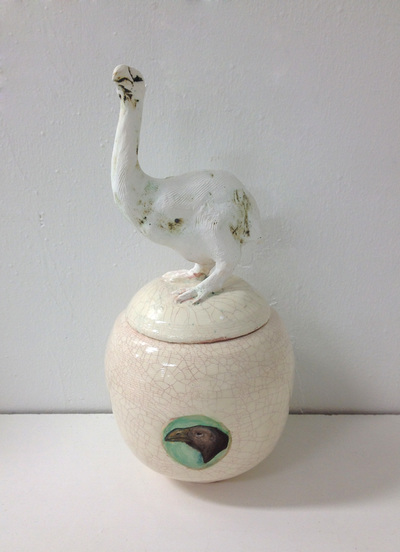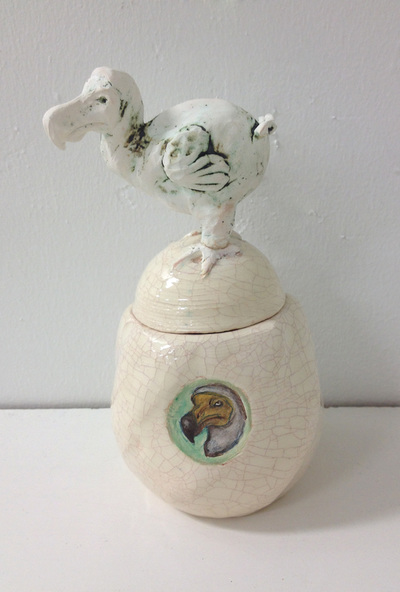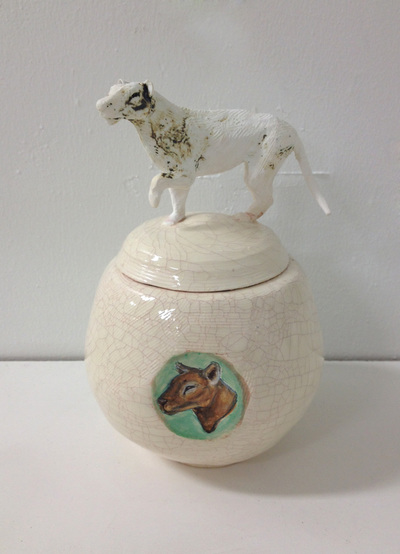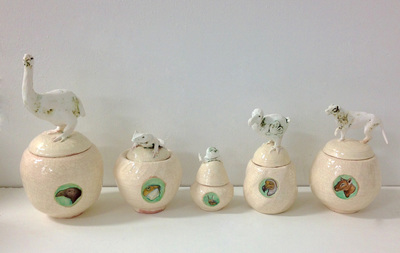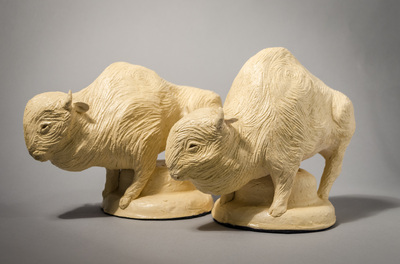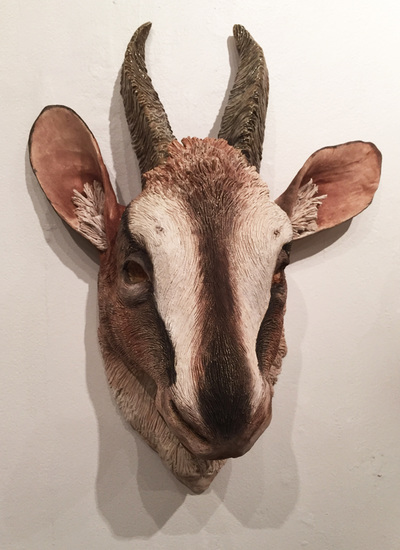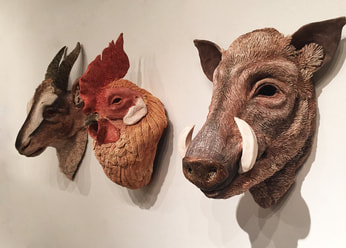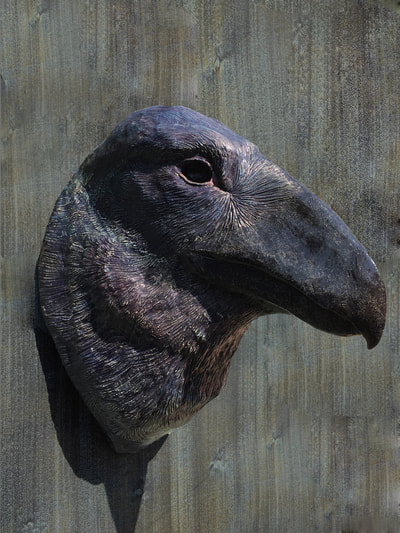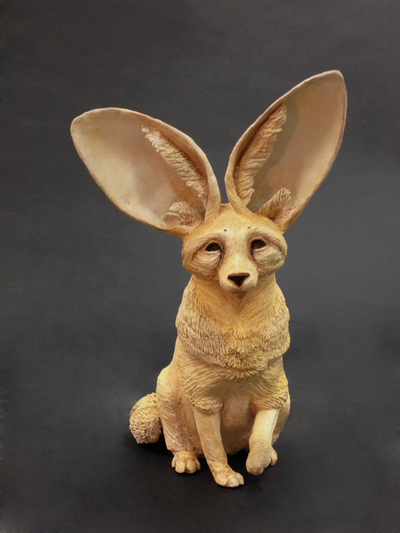Awarded Best in Show 2015 What Remains : Portraits
What Remains Artist Statement Part 1
These portraits of critically endangered animals that are mostly unknown to the general public. They are all unique and beautiful, and are hunted or killed by humans.
The Aye-Aye lemur is native to Madagascar, where according to local legend seeing one is evil and a death omen. They are therefore killed when seen. These amazing animals fill the same ecological niche as a wood pecker using a specialized finger to tap and find grubs in tree trunks. The Pangolin is hunted for it's keratin scales, specialized hairs similar to rhino horn. It is then ground down into a powder to be taken as a medicine. They are the most traffic animal in the world an estimated 10,000 annually are stolen from the wild. The California Leaf-nosed Bat is endangered due to the spread of a fungus that has been introduced by people traveling into the state and exposing the bats. The African Painted Dog is often shot on sight by cattle herders and farmers in South Africa as they are afraid the dogs will harm their live stock. They are also attacked by natural predators such as lions and hyenas making it even harder for the population to rebound from the impact of humans. The Musk Deer is hunted for perfume ingredients found in their musk gland, that gives the deer it's name. They are also unique in that they have adapted to live in dense forest where antlers would get caught so instead they have fangs. The males even have a special muscle that allows them to move them forwards during displays for females.
Part of my goal with this series is to bring attention to these amazing endangered animals and hopefully inspire the viewer to help protect them into the future.
for more details about these animals click here!
These portraits of critically endangered animals that are mostly unknown to the general public. They are all unique and beautiful, and are hunted or killed by humans.
The Aye-Aye lemur is native to Madagascar, where according to local legend seeing one is evil and a death omen. They are therefore killed when seen. These amazing animals fill the same ecological niche as a wood pecker using a specialized finger to tap and find grubs in tree trunks. The Pangolin is hunted for it's keratin scales, specialized hairs similar to rhino horn. It is then ground down into a powder to be taken as a medicine. They are the most traffic animal in the world an estimated 10,000 annually are stolen from the wild. The California Leaf-nosed Bat is endangered due to the spread of a fungus that has been introduced by people traveling into the state and exposing the bats. The African Painted Dog is often shot on sight by cattle herders and farmers in South Africa as they are afraid the dogs will harm their live stock. They are also attacked by natural predators such as lions and hyenas making it even harder for the population to rebound from the impact of humans. The Musk Deer is hunted for perfume ingredients found in their musk gland, that gives the deer it's name. They are also unique in that they have adapted to live in dense forest where antlers would get caught so instead they have fangs. The males even have a special muscle that allows them to move them forwards during displays for females.
Part of my goal with this series is to bring attention to these amazing endangered animals and hopefully inspire the viewer to help protect them into the future.
for more details about these animals click here!
What Remains : Urns
What Remains Artist statement Part 2
The Urns are of already extinct animals, gone due to human impact. The Moa was hunted to extinction within a hundred years of people arriving in New Zealand it was last seen 1445 c.e. The Tasmania Tiger or Thylacine wasn't even recognized as endangered until there was only one left it was last seen in 1936 c.e. The Dodo is famous for being so ignorant of predation that when human arrived on their island they didn't know to run away it was last seen in 1688. There are not even any complete remains. The Golden frog was located in a small part of rain forest and a strange disease wiped out the species before conservation could attempt to help, it is believed that water and air pollution was the cause it was last seen in 2004. The Malaysian snail lived on one hill side in Malaysia and it was deforested killing the entire population. It may have been one hill side but it was the snails whole world, they were wiped out only just last year.
The Urns are of already extinct animals, gone due to human impact. The Moa was hunted to extinction within a hundred years of people arriving in New Zealand it was last seen 1445 c.e. The Tasmania Tiger or Thylacine wasn't even recognized as endangered until there was only one left it was last seen in 1936 c.e. The Dodo is famous for being so ignorant of predation that when human arrived on their island they didn't know to run away it was last seen in 1688. There are not even any complete remains. The Golden frog was located in a small part of rain forest and a strange disease wiped out the species before conservation could attempt to help, it is believed that water and air pollution was the cause it was last seen in 2004. The Malaysian snail lived on one hill side in Malaysia and it was deforested killing the entire population. It may have been one hill side but it was the snails whole world, they were wiped out only just last year.
Awarded Best in Show 2014 Your Move: Predator vs Prey Chess set
Artist Statement
Over five hundred million years ago, one of the first Predators evolved; all it took was a simple mouth. This early animal started a chain reaction that caused one of the largest bursts in biodiversity in the earth's natural history, a back and forth evolutionary arms race, of each having to outdo the predators/prey in order to survive. An example of this relationship is an early animal having a mouth to eat others, then the prey evolving spines to prevent being eaten. So then the predators evolve claws that can break through the spines and eat them anyway, and so on until you get modern day predator and prey relationships. This train of thought led me to think of chess and its use of strategy and taking of turns of the players. The relationship between predator and prey is reflected in the chess game. On the Prey side they are hunted by the same pieces on the Predator side. The King and Queen, a Lion and Lioness ,lead the Predators while a male and female Kudu, a favorite prey animal of the lion, lead the Prey. The pawns of the predators are Shrews which are prolific hunters themselves but because of their size they are often on the menu. The pawns of the prey side are mice, a keystone species, so called because they are common and eaten by a wide variety of predators. Each piece has a direct relationship between its opposite: the bishops are jaguars vs. tapirs, the knights are buffalo vs. wolves, rooks are birds of prey vs. hares, etc. These are sets of animals that have been locked in a race against each other for millions of years, the process of evolution honing different ways to defend themselves or out-maneuver the other. Tapir's for example will go into water to avoid predation, so jaguars learned to love the water unlike most other big cats. Hares evolved speed and camouflage so birds of prey gained extraordinary vision. The evolutionary chess game has already begun, what will your move be?
Over five hundred million years ago, one of the first Predators evolved; all it took was a simple mouth. This early animal started a chain reaction that caused one of the largest bursts in biodiversity in the earth's natural history, a back and forth evolutionary arms race, of each having to outdo the predators/prey in order to survive. An example of this relationship is an early animal having a mouth to eat others, then the prey evolving spines to prevent being eaten. So then the predators evolve claws that can break through the spines and eat them anyway, and so on until you get modern day predator and prey relationships. This train of thought led me to think of chess and its use of strategy and taking of turns of the players. The relationship between predator and prey is reflected in the chess game. On the Prey side they are hunted by the same pieces on the Predator side. The King and Queen, a Lion and Lioness ,lead the Predators while a male and female Kudu, a favorite prey animal of the lion, lead the Prey. The pawns of the predators are Shrews which are prolific hunters themselves but because of their size they are often on the menu. The pawns of the prey side are mice, a keystone species, so called because they are common and eaten by a wide variety of predators. Each piece has a direct relationship between its opposite: the bishops are jaguars vs. tapirs, the knights are buffalo vs. wolves, rooks are birds of prey vs. hares, etc. These are sets of animals that have been locked in a race against each other for millions of years, the process of evolution honing different ways to defend themselves or out-maneuver the other. Tapir's for example will go into water to avoid predation, so jaguars learned to love the water unlike most other big cats. Hares evolved speed and camouflage so birds of prey gained extraordinary vision. The evolutionary chess game has already begun, what will your move be?
Zooprints Monument at the San Francisco Zoo
Located at the San Francisco Zoo this 4'x8' ceramic monument addresses how everyone leaves footprints. On Display since fall of 2013
Domestic Bliss
Domestic Bliss is an homage to both the living and extinct wild animals that Humans have domesticated. The series currently features the relatives of Goats, Chickens and Pigs. The Bezoar Ibex (female), Red Jungle Fowl and Wild Boar. Pictured Below on display at CCACA in Davis, CA. spring 2016
Stand Alone Pieces
Five: The Senses Series
Artist Statement
As humans we tend to think of ourselves as being very separate from other animals around us but we are not so different at our core. Part of this is how we perceive our world: Sight, Hearing, Smell, Taste and Touch. Many animals experience their environment much like us, only amplified. In this series I chose five animals that I felt best represented the five human senses but in a more intense way. Hearing is a Bat-eared Fox, which uses it's dramatically large ears to hear it's prey under the sand. Touch is a North American Raccoon, which have so many nerve endings in their hands they can practically taste with them. Sight is a Great Horned Owl, their eyes are so large in proportion to their body that the eye itself is fused to to the sockets to support their enormous size. Smell is a Brown Bear, which can pick up a scent from eighteen miles away. Taste is a Gopher snake, as all snakes have a Jacobson's Organ that connects to their tongue allowing them to taste which direction scent particles are coming from by flicking it out of their mouth. By learning about these animals I hope you the viewer find a connection to nature, like the smell of trees or the sound of rain and know that we are not alone in feeling these things.
Displayed at CCACA spring of 2013 and Spring show 2014
As humans we tend to think of ourselves as being very separate from other animals around us but we are not so different at our core. Part of this is how we perceive our world: Sight, Hearing, Smell, Taste and Touch. Many animals experience their environment much like us, only amplified. In this series I chose five animals that I felt best represented the five human senses but in a more intense way. Hearing is a Bat-eared Fox, which uses it's dramatically large ears to hear it's prey under the sand. Touch is a North American Raccoon, which have so many nerve endings in their hands they can practically taste with them. Sight is a Great Horned Owl, their eyes are so large in proportion to their body that the eye itself is fused to to the sockets to support their enormous size. Smell is a Brown Bear, which can pick up a scent from eighteen miles away. Taste is a Gopher snake, as all snakes have a Jacobson's Organ that connects to their tongue allowing them to taste which direction scent particles are coming from by flicking it out of their mouth. By learning about these animals I hope you the viewer find a connection to nature, like the smell of trees or the sound of rain and know that we are not alone in feeling these things.
Displayed at CCACA spring of 2013 and Spring show 2014







